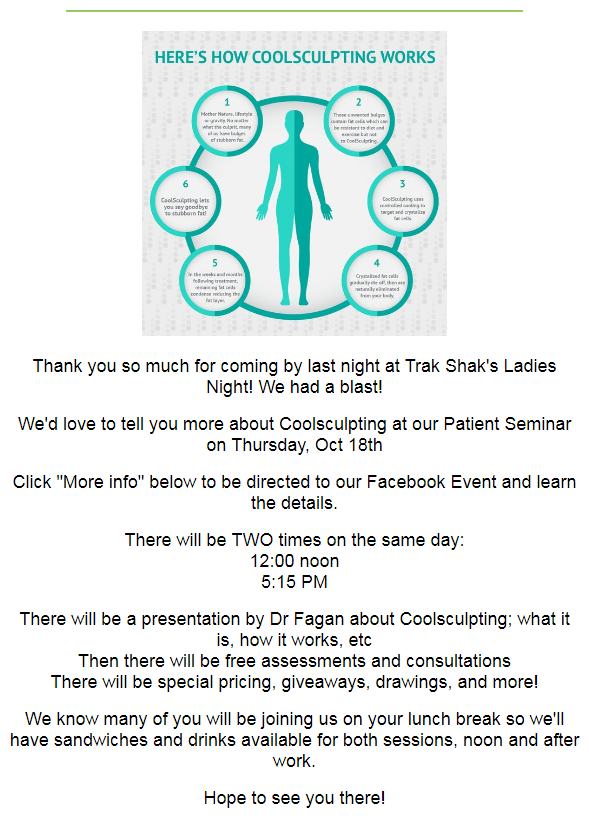Category: Uncategorized
Dr Fagan on Doc Talk
Black Friday Special
November 2018 newsletter
Holiday Open House
Coolsculpt Patient Seminar
February News
Tennis Elbow – Not Only for Tennis Players
Do you have to play tennis to have “tennis elbow”?
The answer is ‘no.’ Although tennis elbow commonly affects tennis players, it also affects other athletes and non-athletes! Someone who is involved in activities requiring repetitive arm, elbow, or wrist movement. Tennis elbow is caused by an inflammation of the tendons surrounding the elbow, especially near the forearm area. Other activities that can lead to the development of tennis elbow includes golfing, playing basketball, gardening, sweeping, vacuuming, or scrubbing.
Symptoms:
- Tenderness over lateral elbow
- Pain with gripping (ex. shaking hands)
- Pain with wrist movements or extensions (ex. turning door knobs, pouring from a pitcher)
- Morning stiffness
Treatment:
- Rest and ice the injury
- Avoid aggravating activities
- Exercises to stretch and strengthen forearm muscles and tendons
- Non-steroidal anti-inflammatory medication and cortisone injections
- Use braces and support on affected elbow and tendons
If pain continues and does not subside, call Fagan Sports Medicine for an appointment: 205.879.8206
Stress Fractures – A Sneaky, But Common Injury
Stress fractures are very common with athletes who run and jump on hard surfaces. That means you basketball players, distance runners, and even ballet dancers. Stress fractures are commonly known as “very small sliver or crack in the bone.”
Why do stress fractures occur?
Stress fractures happen when there is unusual or repeated stress on a bone. The muscles that are meant to support and protect that bone become fatigued, which leaves them unable to absorb added shock from an activity. When that bone’s response stress cannot maintain the pace of the repetitive demands, a stress fracture is very likely to result from this repeated trauma.
Repeated trauma: Bones are constantly attempting to remodel and repair themselves, especially during a sport where extraordinary stress is applied to the bone. Over time, if enough stress is placed on the bone that it exhausts the capacity of the bone to remodel, a weakened site – a stress fracture – on the bone may appear.
The fracture does not appear suddenly. It occurs from repeated traumas, none of which is sufficient to cause a sudden break in the bone.
How does one prevent stress fractures?
Proper footwear and warm-up/cool-down exercises are great ways to help prevent stress fractures in the lower extremities. Before a run or any other strenuous activity, walk and stretch out in order to warm up your muscles that protect your bones. Focus on strengthening and stretching the calf muscles. And always try to stretch and cool down after an exercise session. By strengthening and stretching your muscles after an exercise session, you are preparing your muscles for the next workout and your every day activities.









Recent Comments